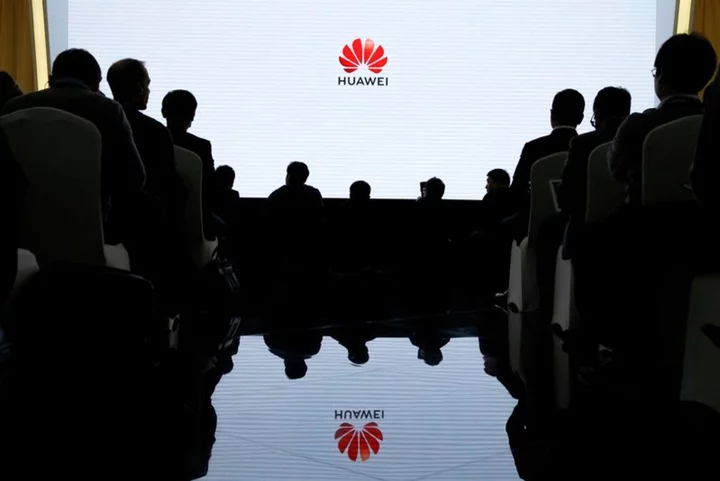By David Kirton and Max A. Cherney
SHENZHEN, China/SAN FRANCISCO, California Huawei Technologies' breakthrough in making an advanced chip underscores China's determination and capacity for fighting back against U.S. sanctions, but the efforts are likely very costly and could prompt Washington to tighten curbs, analysts said.
Huawei unexpectedly unveiled the latest Mate 60 Pro smartphone last week during U.S. Commerce Secretary Gina Raimondo's visit in China, as the government readies a new $40-billion investment fund to bolster its developing chip sector.
The Mate 60 Pro is powered by its proprietary chip Kirin 9000s and manufactured by the country's top contract chipmaker SMIC using an advanced 7 nanometre (nm) technology, according to a teardown by Ottawa-headquartered TechInsights.
Its findings and claims by early users about the phone's powerful performance indicate China is making some headway into developing high-end chips, even as Washington has over the recent years ramped up sanctions to cut its access to advanced chipmaking tools.
It "demonstrates the technical progress China’s semiconductor industry has been able to make without EUV tools. The difficulty of this achievement also shows the resilience of the country’s chip technological ability," TechInsights analyst Dan Hutcheson said.
EUV refers to extreme ultraviolet lithography and is used to make 7 nm or more advanced chips.
"At the same time, it is a great geopolitical challenge to the countries who have sought to restrict its access to critical manufacturing technologies. The result may likely be even greater restrictions than what exist today."
Jefferies analysts said TechInsights' findings could trigger a probe from the U.S. Commerce Department's Bureau of Industry and Security, create more debate in the U.S. about the effectiveness of sanctions and prompt the Congress to include even harsher tech sanctions in a competition bill it is preparing against China.
"Overall the US-China tech war is likely to escalate," they said in a note.
A U.S. Department of Commerce representative did not immediately reply to a request for comment on Tuesday morning.
Huawei declined to comment. SMIC and China's State Council, which handles press queries on behalf of the Chinese government, did not immediately respond to requests for comments.
LIMITED ACHIEVEMENT
The most advanced chip SMIC had previously been known for making was 14nm, as it was barred by Washington in late 2020 from obtaining an EUV machine from Dutch firm ASML.
But TechInsights last year said it believed SMIC had managed to produce 7 nm chips by tweaking simpler DUV machines it could still purchase freely from ASML.
Some analysts including Jefferies' said there was also a possibility Huawei had purchased the tech and equipment from SMIC to make the chip rather than doing it in collaboration.
Whoever is making the chip, Tilly Zhang, an analyst at Gavekal Dragonomics, downplayed the success, citing a low yield rate which reduces the number of useable chips from each wafer and raises costs, and new export controls imposed by the Netherlands that will limit SMIC's access to more immersion DUV machine.
"They have just demonstrated that they are willing to accept much higher costs than are normally considered worthwhile ... It is only the combination of Huawei’s own large financial resources and generous government subsidies that could allow it to sell phones using these chips at normal market prices," Zhang said.
Reuters reported on Tuesday that China is set to launch a new state-backed investment fund that aims to raise about $40 billion for its chip sector, as the country ramps up efforts to catch up with the U.S. and other rivals.
Some research firms forecast SMIC's 7 nm process has an yield rate below 50%, versus the industry norm of 90% or more, and it would limit shipments to around 2-4 million chips, not enough for Huawei to regain its former smartphone market dominance.
Jefferies analysts reckon Huawei is preparing to ship ten million units of the Mate 60 Pro, though it may struggle to support that quantity with China-made 7 nm chips.
In that case it could turn to 10 nm chips, but with an estimated 20% yield, which refers to the number of working chips on each silicon wafer, Jefferies said, it would be far below the 90% for most consumer devices.
"The (U.S.) controls are imposing high costs for producing controlled technologies in China," said Doug Fuller, a chip researcher at the Copenhagen Business School, adding that the Chinese government was likely footing the bill.
(Reporting by David Kirton and Max Cherney, writing by Brenda Goh; Editing by Miyoung Kim and Nick Zieminski)

